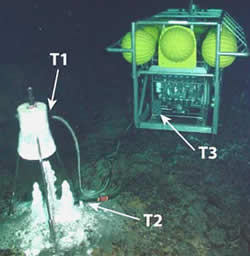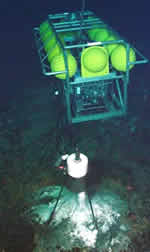|
| |

T3 is
in the little box on the front frame.
T2 should be in the vent, to the right of the tripod.
T1 is on the left side of the tripod, goes in at the top of the titanium,
beneath the white syntactic foam. (click
for full-size) |
The NeMO
Net RAS sampler was deployed on September 1, 2003 in the ASHES
vent field. The system is located at Virgin vent, a high-temperature,
anhydrite chimney. The RAS will monitor the chemistry and temperature
of this vent over the next year.
The instrument
is capable of collecting 48 vent fluid and particle samples in a time-series.
The system is a McLane 48-500 Remote Access Sampler, with hardware and
software enhancements done at PMEL. Temperature measurements are made
every 10 minutes. The sampler is programmed to take a water/particle sample
once per week and collect chemical sensor data (pH and H2S) twice per
week. The system can also be sent a command at any time via satellite
to collect samples or send back temperature data. This interactivity will
allow us to take samples quickly and at critical times, for example in
response to any seismic or volcanic activity, long before any ship could
get to the site. By having this instrument in place we hope to learn more
about the dynamic early stages of such events.
| |

RAS being deployed at Virgin vent. (click
for full-size) |
|
For more
information use the following links to NeMO Explorer:
Hydrothermal
vents
Anhydrite
chimneys
Diffuse
vents
ASHES virtual reality
site
Video clip
of Virgin vent
NeMO at Axial
Volcano
|

